Rats are one of the very common pests that will try to gain access to your home through the yard. You may notice little holes here and there while you’re gardening. What can be worse, you may even see them close to the entry to your house. Luckily, there are multiple ways to combat this problem, and we’ll show you how to get rid of rat holes in yard.
That way, you’ll get to choose the best possible option for you and start tackling this problem as soon as possible. Without wasting any more time – let’s get right into this topic!
Why Do I Have Rat Holes in Garden?
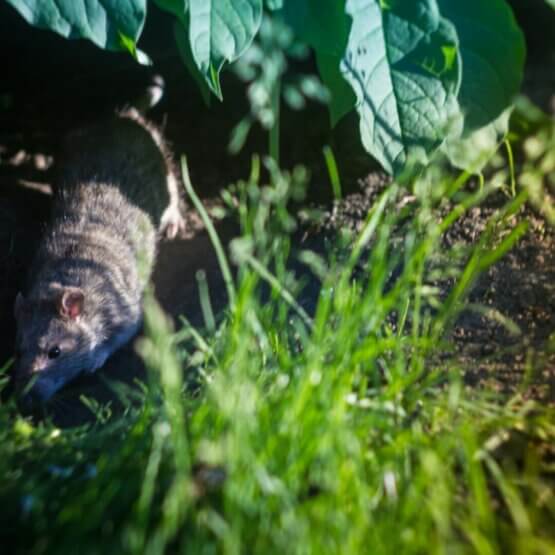
The main reason why rats burrow in gardens is that they want to be close to the food source.
If you noticed rats roaming around your garden, it is very likely that you left them something to munch on.
Now, this isn’t the time and place to feel guilty. Rats are intelligent animals and can very easily sense when there is food nearby.
In fact, sometimes the plants you have in your garden may be their preferred food choice. This mainly includes fruits and vegetables.
It’s useful to gain some knowledge on what plants rodents are attracted by. That way, you can have the upper hand when dealing with rodents.
For example, rats can be attracted to peas, cabbage, carrots, potatoes, and fruits such as bananas, apples, and others.
However, this doesn’t mean that you have to give up on cultivating these fruits and veggies in order to get rid of rodents. We’ll show you exactly what to do in order to get rid of them.
HINT: It may sound like a no-brainer, but make sure you remove any food from your property. This includes leftover dog food or anything similar. Also, remove any sacks of food that are standing anywhere near the affected place on the property.
What Do Rat Holes Look Like?
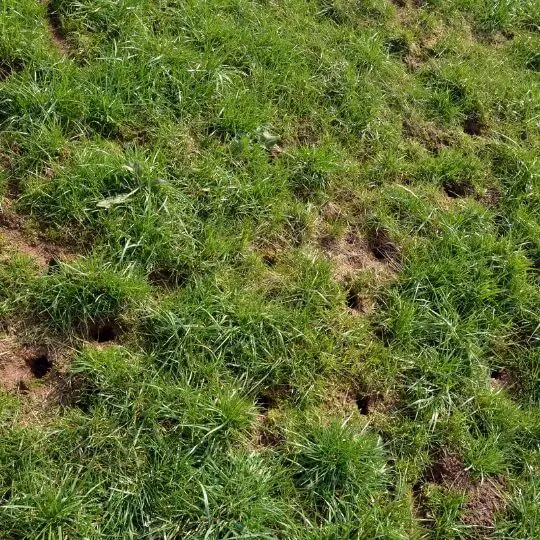
Before you get your hands dirty, you need to make sure that you’re dealing with rats and not some other animal. That’s because we’re going to give you solutions that work best for rats.
Here’s the easy guideline to identify rat holes:
- The Size of Holes
Rats tend to burrow holes with medium to large entries. If you notice very small holes around your yard, chances are you’re dealing with another animal or an insect.
The rat holes should be from two to four inches in diameter. You’ll also notice some dug-up soil near this entry.
- Check for Hidden Spots
One of the most important things for rats (apart from food) is having safe shelter.
That’s why you’ll see rats burrowing underneath the deck, pavement, or sidewalks. Make sure to check any of these spots in order to find the rat nests.
- Bad Odor
If you’re dealing with a rat infestation, the chances of you and others sensing a really bad odor is huge.
This is because rats have very little to no control over their bladder. [2]
They tend to urinate everywhere in the yard and around their nest, which carries a really strong bad odor.
- Droppings
Another important thing to check is the presence of rat fecal droppings around your yard.
- Greasy Trails
Rodents have oil and dirt on their coats which is why they will leave greasy marks behind.
This is even easier to notice when rats use the same trail for longer periods of time.
How Deep Do Rats Burrow?
The rat burrows are known to be 18 inches deep, although this can vary among different species.
When it comes to length, they can settle in holes as long as 3 feet. In fact, rats usually dig up tunnels which serve as a shelter for a number of rats (sometimes even dozens).
However, know that rats can easily enlarge their shelter if they sense close access to food.
How to Get Rid of Rats in Garden?
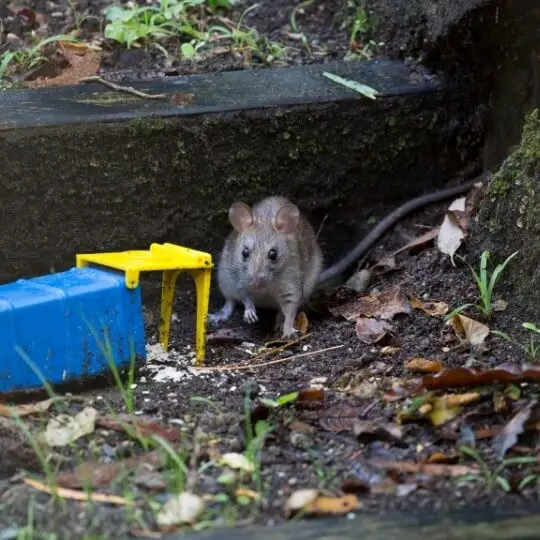
To show you how to get rid of rat holes in yard, you need to get rid of rats first.
Remove Food and Water Sources
Without any doubt, this is the first and most important step in the whole process of getting rid of rats. Try to build fences around your plants, remove any pet food and also any type of standing water.
Unclutter the Garden
Gardens or yards that have a messy landscape are more likely to have pests infestations. This is because any messy bushes, dead plants, and garbage serve as an additional place for pests to shelter.
Also, one thing rats absolutely love to munch on is garbage – so make sure you keep your garden clean.
Flush the Holes
One humane option to get rid of rats is to flush their burrows with streams of water.
Rats hate having their shelters and their routines disturbed. The streams of water from your garden hose are likely to shock them enough, so they run away and hopefully don’t come back.
Use Non-Poisonous Deterrents
It’s usually advised to avoid using the poison and traps as the first possible option. Sprinkling poison around your yard is never a good idea, not even for the plants, and especially not for children and pets!
Luckily, rats are easily repelled by some smells, such as hot spices. [3]
You can use hot chili pepper, garlic, cayenne pepper, onion, clover, and even coffee grounds!
Rats also hate the smell of peppermint oil (mint) and lavender. Just add some of these around the rat holes and watch those pesky rodents run away for good.
Use Dry Ice
CAUTION: This method, along with the next two, is best left to professionals to handle.
Dry ice is used by professionals to suffocate the rats and kill them inside the rat holes. This is achieved as the dry ice melts and releases large amounts of carbon dioxide.
When handled properly, dry ice is actually a more humane option than other traps and poisons used to kill rats. It is also non-toxic – meaning that there are no toxic chemicals released in your yard.
Smoke Bombs
This is yet another option that should be carried out exclusively by professionals.
Smoke bombs release a lot of toxins and can also be dangerous to house pets and children. They also might be illegal in some of the states.
However, the killing of rats is not illegal. Most states even require you to kill rats, although there are some restrictions.
Traps
This is probably the least humane way to kill rodents. However, there are plenty of rat traps available on the market despite that.
NOTE: Wondering if you can pour bleach down rat hole? Actually, bleach can be effective in repelling rats. However, bleach is never enough to get rid of rats – you need to also remove any clutter and close the rat holes. Also, it’s best to avoid pouring bleach if you have pets or children around.
Methods to Get Rid of Rat Holes
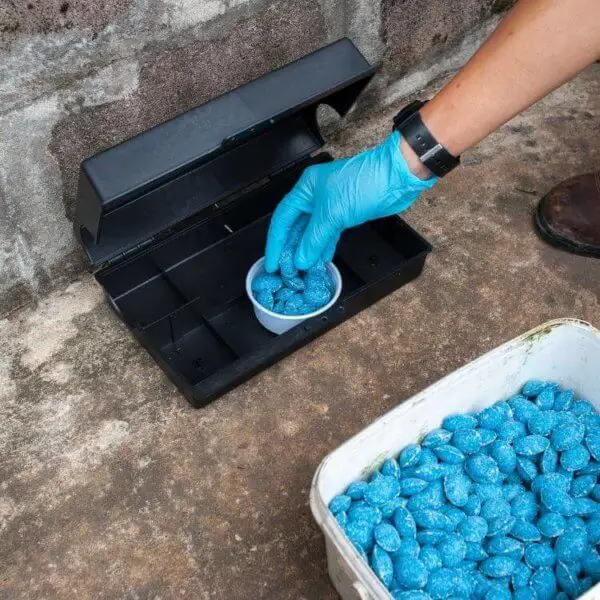
After you get rid of the rats, the next step is to fill in the rat burrows and block the excess to these rat holes. That way, rats or some other animals don’t come back to the shelter.
NOTE: Make sure there are no rats inside before you fill in the burrow and block the excess. If you don’t, you run the risk of facing the risk of awful odors of decomposing rats.
It’s best to flush the rat holes with water first, so you can make sure no rats are still inside the shelter. Get rid of rats in sewer pipes and also stop rats from climbing the drain pipes.
- Fresh Soil
The simplest and easiest way to fill in the rat burrows is to simply fill them with some fresh soil. Grab a shovel and just keep filling in the rat hole until the shelter is completely filled with soil.
- Steel Wool
The next most effective way to fill in the rat holes is with steel wool. The rats can’t chew on steel wool, so it’s very unlikely that they will inhabit this shelter once again. Steel wool is also fairly cheap and easy to get in the local stores.
- Concrete
This is usually the easiest option and also solves the problem almost instantly. All you need to do is pour down some concrete in order to fill the rat holes.
Please note that rats are known to chew through concrete, so steel wool would be a better option for more severe cases. [5]
ALSO READ: Can rats chew through PEX pipes?
- Caulk
You may wonder why caulking material is even on the list since rats can easily chew even concrete.
Caulking is usually mixed with steel wool because it fixes it in place, so rats can’t move and drag the steel wool.
- Wire Mesh
The wire mesh (especially the copper wire mesh) is also a popular way to close off the rat burrows.
They work in a very similar way to steel wool, so just choose the one that you may find more appropriate.
Is It Dangerous to Have Rats in Garden?
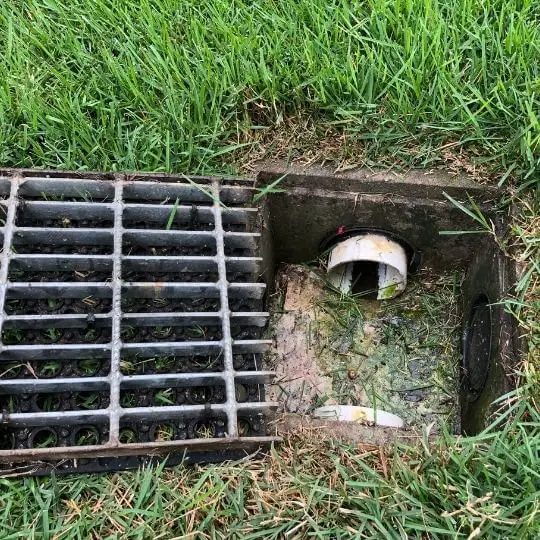
It can be quite dangerous to have rats in the garden, and this problem is certainly not the one to be taken lightly.
Not only do they ruin the landscape of your garden, but the problems that rats cause are also way more serious.
First, the rats carry a lot of diseases that can be passed to humans. You definitely want to avoid this – not to mention children and pets, who can unknowingly get in contact with rats easier.
Secondly, the rats tend to pick a spot in your yard in order to gain better access to your home. That’s why it’s best to get rid of them before they have found a way to enter the house.
If you notice rats or rat holes in your yard, it’s advised to take some action as soon as possible. It’s best to consult Pest Control professionals if you’re unsure about what steps to take.
How to Prevent Rat Holes in Yard?
To prevent having rats and rat holes in your yard in the future, make sure you:
- Keep your garden neat
- Remove any garbage
- Remove any standing water and food
- Routinely check your plants
- Fix/seal any leaking drains/pipes
- Seal the garbage cans
- Consult professionals for pest control
Finally, know that tree roots can penetrate pipes as well, so the rats are not always the sole problem.
The Takeaway
Rats are not only annoying, but they can also be a source of many other problems as well.
They ruin your property, emit bad odors, and carry dangerous diseases. If left untreated, they can easily move into your house in order to get more food.
Fortunately, now you know the tricks on how to get rid of rat holes in yard. Don’t wait any longer – put these tricks to good use so your garden can flourish the way it used to!

Michael Davis is a heating & plumbing expert who currently works as independent contractor in SC. He also writes for Plumbertip.
For almost 10 years he worked on various plumbing tasks across South Carolina.


